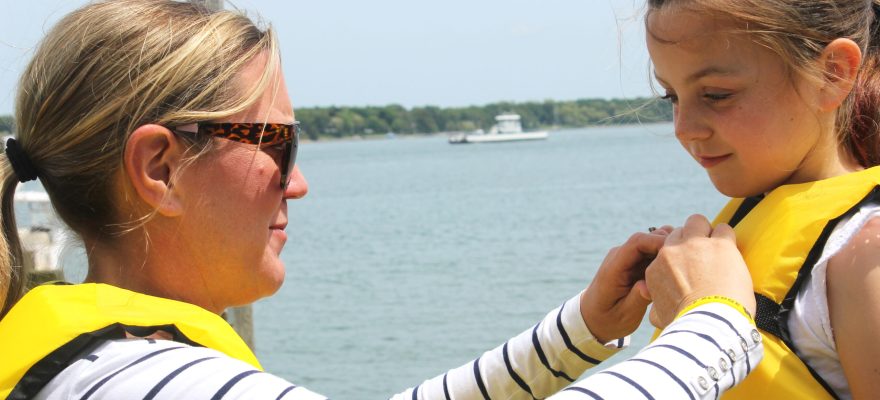
Boating is a great summer activity that so many families enjoy. But it’s important to take safety precautions around boating activities in all kinds of water, whether it be pools, oceans, lakes or rivers. Among the most important boat safety tips for families and individuals is to always wear a life jacket.
According to U.S. Coast Guard boating statistics, 83% of the people who died in a boating incident drowned because they weren’t wearing a life jacket. With boating season right around the corner, now is the time for parents to begin teaching their children about the importance of boating safety so their family doesn’t become a part of that tragic statistic.
“Drowning is fairly common,” Gail R. Kulp, executive director at Sea Tow Foundation, an organization that runs the Life Jacket Loaner Program, said while explaining why people don’t wear life jackets. “They may have thought that they were great swimmers or they weren’t going very far, or they felt they were just in a canoe or kayak so they don’t need to worry about it. But drowning can happen quickly. And if you’re knocked out of a boat, and you’re injured or knocked unconscious, a life jacket is one thing that is going to save your life.”
The U.S. Coast Guard requires everyone ages 13 and younger to wear a life jacket, though Kulp recommends everyone wear a life jacket on the water regardless of age. Sea Tow’s Life Jacket Loaner Program provides free life jackets for families to use and borrow at over 1,000 loaner stand locations throughout the country, including locations in New York and New Jersey. Each year, Sea Tow awards businesses, communities and organizations with life jackets to set up loaner stations along popular waterways in their areas.
“We’re excited to work with the Sea Tow Foundation to bring a brand-new Life Jacket Loaner Station to boaters in our area,” said Charles Melchner, owner of the Mahopac Marina in Mahopac, NY. “This will help ensure boaters of all ages have enough properly fitting life jackets, which will go a long way toward keeping people safe while they’re out enjoying the beautiful Lake Mahopac waters.”
Boat Safety Tips for Families
Kulp shared boat safety tips that families and individual boaters should follow when they’re out on the water. The most important tip? Wear a life jacket — and wear it correctly.
“The biggest key is to make sure the life jacket fits correctly. So, it’s not just that you’re wearing a life jacket, but that it fits,” Kulp explained. “We like to tell people that life jackets aren’t like winter coats. You don’t buy one thinking you’ll be able to wear them for a few winters and grow into it. You buy it or borrow it for the size that you are. And when you outgrow it, you need to get the next size.”
Additional boat safety tips for families from the Sea Tow Foundation include:
Designate a sober skipper. Before heading out on the water, someone who knows how to safely operate the boat should be chosen as the sober skipper. His or her job is to ensure the safety of everyone on board and make sure all return safely to land at the end of the voyage. (You can take a pledge here!)
Dress in layers. Although the air temperature may be warm, the water may be very cold. Breezes out on the water are often colder than they would feel on land. Dressing in layers allows you to add or remove clothing as the temperature changes.
Take a boating safety class. This class teaches you how to safely fuel a boat, perform basic maintenance, operate the boat according to navigation rules and provides tips on how to avoid or respond to emergencies on the water.
Use an engine cut-off device. Before starting the engine, make sure to attach an engine cut-off device such as the factory-installed lanyard or an after-market electronic device to the operator of the boat. This will ensure that the boat’s motor stops if the operator accidentally falls overboard so that he or she can be recovered safely. Electronic versions can also include attachments for all of the boat’s occupants.
Create a float plan. This explains where a boater is headed and when he or she plans to return. It should be given to a trusted friend or family member staying on land. This is important in case an emergency happens or the boater does not arrive back on time because authorities will know where to focus their search efforts.
Watch the weather. When it comes to boat safety tips for families, consider weather. Before any boating trip, it’s important to check the forecast, and check it throughout the course of the day. Storms can form over the water, especially in the warmer months, and it’s best to be prepared instead of stuck fighting nature.
Keep it clean. Millions of people enjoy waterways every year and thousands of species of fish live here, so it’s important to keep the water clean. Don’t throw trash overboard.
Update your charts. A nautical chart shows a boater where waterway markers, navigation channels, sandbars and obstructions are located. These items are often moved by humans or Mother Nature. Having an up-to-date chart will help you safely maneuver the boat and avoid these dangers so that you can get across the water safely.
Carry a beacon. A personal locator beacon (PLB) or a larger emergency position indicating radio beacon (EPIRB) can be used in an emergency to help rescuers find you. They work by emitting a satellite signal that alerts authorities to your exact location. And because they work off satellites, they’re more reliable than cell phone signals that may not work in remote areas.
For more information, visit boatingsafety.com.
Wanna read more stuff like this? Get our newsletters packed with ideas, events, and information for parents in Staten Island.







